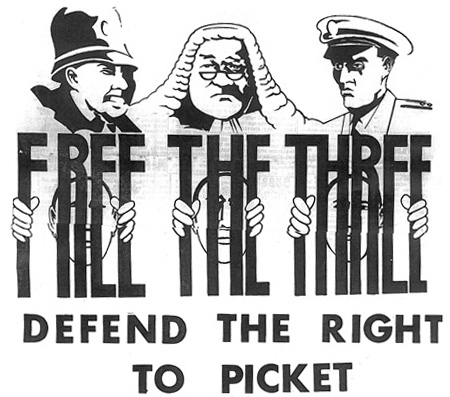 Why we did it
Why we did it
There was never any conscious strategy to engage with the building industry. Our engagement grew out of the people we got to know from other situations – active trades union militants with long experience. We learnt from them. The background was the successful building workers’ strike in late summer 1972 to back up demands for better pay and conditions. (At the time there were more deaths due to poorly observed safety regulations than in the mines). After the strike, the ‘Shrewsbury 24’, were prosecuted for ‘crimes’ linked to picketing. (One of them was Ricky Tomlinson who after his tangles with the prison system went on to star in TV’s The Royle Family and other films.) We thought it was important to get involved in defending them (see page 7 of In the Beginning).
What we did
In December 1973 three of the Shrewsbury 24 were jailed and some of the ELBF group were invited to get involved in fundraising for the East London Shrewsbury 24 Defence Committee and families of pickets (see Shrewsbury Social). In early 1974 six more of the ‘24’ went on trial. By June 1974 we were involved in weekly meetings of the East London Defence Committee.
In August 1974 the committee was renamed Building Workers Action Group (BWAG). During this time, one of the ELBF group got a job on a building site, and carried on working in building till early 1976. He was working on a GLC building site in Juniper Street and – with a friend he made on the site – managed to get it unionised within six weeks. By late summer 1974, there were enough workers in the union to win a majority ballot for recognition, so the management was obliged to talk to the union. (See page 3 of Minutes of ELBF General Meeting 18/8/74.) The next site he worked on made more use of sub-contractors, and proved impossible to unionise.
See his account within his personal story
“The work was physically tiring and occupied me all day. The evenings and weekend continued to be intense and demanding, but I felt entitled to draw limits. I befriended another young labourer, idealistic and hungry for knowledge about socialism, and together we unionised the site we were working on. The song 'You can't get me, I'm part of the union' had been big in the charts, and groups of young labourers spontaneously would burst into the refrain. It was good to feel briefly part of the organised working class. We had a laugh.
The next site I worked on was bigger and tougher; divide and rule among the sub-contractors was endemic. There was no chance of organising there, even though I brought along some of the experienced militants I knew to speak in the canteen at meal break.”
In the autumn of 1974, as Des Warren and Ricky Tomlinson were sent back to jail, a number of building sites nationally, especially in the north-west, stopped work (see Liverpool Big Flame article Free the Two Now!). In January 1975 we took part in a mass lobby in support of the ‘24’ that marched from Tower Hill to the Temple. Despite the protests, Ricky Tomlinson and Des Warren served two and three years respectively; after Des’s death in 2005 a campaign was launched to get a pardon for them which continues.
Looking Back…
Rising unemployment and the severe recession of the late ’70s and early ’80s, together with the cessation of local authority house-building under Margaret Thatcher, severely undermined union power in the building industry. These factors, together with the practice begun in the late ’80s of importing skilled labour teams from abroad, meant that union power has never really recovered. Recently the pervasiveness and longevity of the blacklisting that began at that time has been revealed. Much as it has scandalised some sections of the media and shocked those revealed to have been its victims, it is not surprising to those of us who were active at that time and long suspected the practice.